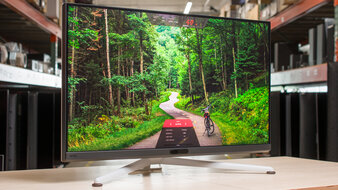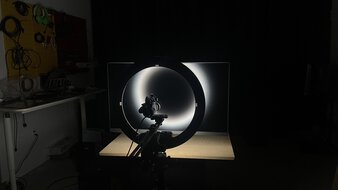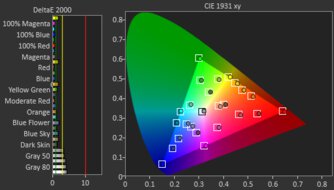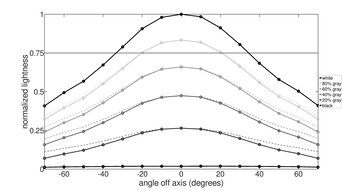One of the latest emerging technologies in the monitor market is Mini LED displays. This is a type of backlight behind the LCD panel that includes many small LED lights. Combined with a proper local dimming feature, it helps the monitor display deeper blacks with brighter highlights and less blooming compared to edge-lit backlighting. You also have to consider the number of dimming zones the monitor has, as more zones allow for finer control around bright objects, but the number of zones doesn't guarantee good local dimming. Although they don't deliver the same deep blacks as OLEDs, Mini LED monitors tend to cost less, get brighter, and don't risk burn-in like OLEDs, so these are good alternatives if you want premium picture quality without getting an OLED.
While the Mini LED monitor market is still fairly limited, there are different options available. Most have a 4k resolution for detailed images, and there are lower-end 1440p options, too. When looking for a new monitor, consider how you'll use it and how it performs. For example, a monitor with good picture quality with bright highlights and vivid colors is important for most uses, and if you're a gamer, you'll also want a fast response time for sharp motion with quick-moving objects.
We've bought and tested more than 370 monitors, and below are our picks for the best Mini LED monitors available. See our recommendations for the best HDR monitors, the best multimedia monitors, and the best HDR gaming monitors.
Quick Look




Looking to save on your next monitor? We've got you covered! Check out our Early Black Friday 2025 Deals article to see what's worthwhile this year.
-
Best Mini LED Monitor
 HDR Picture7.6SDR Picture7.4Brightness9.3Color Accuracy8.8PC Gaming7.9Console Gaming8.5Editing8.2Contrast7.0Local Dimming6.5Size32"Pixel TypeIPSMax Refresh Rate144 HzSee all our test resultsNative Resolution3840 x 2160
HDR Picture7.6SDR Picture7.4Brightness9.3Color Accuracy8.8PC Gaming7.9Console Gaming8.5Editing8.2Contrast7.0Local Dimming6.5Size32"Pixel TypeIPSMax Refresh Rate144 HzSee all our test resultsNative Resolution3840 x 2160The best Mini LED monitor we've tested so far is the BenQ MOBIUZ EX321UX. It's a premium 4k, 32-inch monitor that features 1,152 dimming zones. These help improve its contrast by deepening blacks against bright highlights, but its downside is that it has haloing around bright objects. While it's not too distracting with real content, there's more haloing in general desktop use, so you may prefer disabling local dimming while browsing the web if this bothers you. However, the main advantage of getting this Mini LED monitor is how bright it gets. It's one of the brightest monitors we've tested, so it fights glare without any issues, and it highlights really pop in HDR. It also displays a wide range of vivid colors in HDR for a punchy and vivid viewing experience.
Besides that, it's a good gaming monitor thanks to its 144Hz refresh rate and consistently fast response time for sharp motion. Plus, It supports HDMI 2.1 bandwidth to take advantage of gaming consoles and DisplayPort 2.1 bandwidth at UHBR10 speeds, so it doesn't need to use compression to reach the max refresh rate over either connection. Its 4k resolution also helps deliver sharp and detailed images for any type of gaming.
-
Best Upper Mid-Range Mini LED Monitor
 HDR Picture7.8SDR Picture8.2Brightness7.7Color Accuracy8.8PC Gaming8.2Console Gaming8.7Editing8.2Contrast8.5Local Dimming7.0Size32"Pixel TypeVAMax Refresh Rate240 HzSee all our test resultsNative Resolution3840 x 2160
HDR Picture7.8SDR Picture8.2Brightness7.7Color Accuracy8.8PC Gaming8.2Console Gaming8.7Editing8.2Contrast8.5Local Dimming7.0Size32"Pixel TypeVAMax Refresh Rate240 HzSee all our test resultsNative Resolution3840 x 2160If you find that the BenQ MOBIUZ EX321UX is out of your price range, you can save some money with the cheaper Samsung Odyssey Neo G8 S32BG85. It's a 4k, 32-inch monitor like the BenQ, but one difference is that it's curved, so the edges are brought closer to you. It also has 1,196 dimming zones and a similarly performing local dimming feature, but because it has a higher native contrast ratio than the BenQ, it displays deeper blacks if you don't enable local dimming. Using local dimming also helps make highlights pop, but small highlights are muted, and there's black crush. It doesn't get nearly as bright as the BenQ either, which is a trade-off for getting it. On the plus side, it has minimal haloing around bright objects, as long as you're viewing it from directly in front, as there's more haloing when viewed from the sides.
It's actually better than the BenQ in terms of gaming because it has a higher 240Hz refresh rate for a smoother feel. While it has a fast response time at any refresh rate, too, there's smearing and inverse ghosting with fast-moving objects. You should know that this monitor has known issues, including VRR flicker, pixel inversion, and scanlines, but its pros still outweigh its cons.
-
Best Budget Mini LED Monitor
 HDR Picture8.1SDR Picture7.9Brightness8.9Color Accuracy9.0PC Gaming8.1Console Gaming7.3Editing8.0Contrast8.7Local Dimming8.0Size27"Pixel TypeVAMax Refresh Rate180 HzSee all our test resultsNative Resolution2560 x 1440
HDR Picture8.1SDR Picture7.9Brightness8.9Color Accuracy9.0PC Gaming8.1Console Gaming7.3Editing8.0Contrast8.7Local Dimming8.0Size27"Pixel TypeVAMax Refresh Rate180 HzSee all our test resultsNative Resolution2560 x 1440Some Mini LED monitors are becoming accessible at budget-friendly prices, like the AOC Q27G40XMN. The main trade-off of getting this versus the Samsung Odyssey Neo G8 S32BG85 is that it has a lower 1440p resolution, so images are less detailed. That said, if you're after pure picture quality, this monitor punches above its weight, as it includes a great local dimming feature, even better than the monitors mentioned above, thanks to its 1,152 dimming zones. It displays deep blacks with very bright highlights, and there isn't too much haloing or black crush.
Its local dimming feature does have some bugs, though, as content looks oversaturated depending on the combination of settings you use with local dimming. If this bothers you, you can also consider the similar AOC Q27G3XMN instead. However, it has fewer dimming zones, as it's limited to 336, and its local dimming feature isn't as good overall because of this. That said, the Q27G40XMN is still a fantastic Mini LED monitor that provides great value, especially considering most other entry-level monitors have limited picture quality.
Notable Mentions
-
Xiaomi G Pro 27i:
The Xiaomi G Pro 27i competes with the AOC Q27G40XMN as it has similar specs, like a 1440p resolution. It also has a good local dimming feature with 1,152 dimming zones, and it has better motion handling than the AOC. However, this monitor is hard to find, and it usually costs more than the AOC.
See our review -
Sony INZONE M9 II:
The Sony INZONE M9 II is a 4k monitor that doesn't actually use Mini LED backlighting, but it still has an okay full-array local dimming feature. That said, the Sony monitor is something to consider if you're gaming with the PS5, and it costs less than the Samsung Odyssey Neo G8 S32BG85.
See our review -
Samsung Odyssey Neo G7 S32BG75:
The Samsung Odyssey Neo G7 S32BG75 is a lower-end model than the Samsung Odyssey Neo G8 S32BG85, with the main difference being that the Neo G7 has a lower refresh rate. However, it has the same number of dimming zones as the Neo G8 and performs similarly, so it's something to consider if you don't need the high refresh rate and want to save money.
See our review
Recent Updates
Oct 24, 2025:
We removed the Acer Nitro XV275K P3biipruzx because it's hard to find.
Sep 10, 2025:
We added the BenQ MOBIUZ EX321UX as the 'Best Mini LED Monitor' and renamed the Samsung Odyssey Neo G8 S32BG85 to the 'Best Upper Mid-Range Mini LED Monitor' to better reflect the current market. We also replaced the AOC Q27G3XMN with the AOC Q27G40XMN, which has more dimming zones. Lastly, we added the Samsung Odyssey Neo G7 S32BG75 to the Notable Mentions.
May 21, 2025:
We replaced the INNOCN 27M2V and the Sony INZONE M9 with the Xiaomi G Pro 27i and the Sony INZONE M9 II in the Notable Mentions to better reflect the current monitor market.
Feb 19, 2025:
We introduced a new format to the article and updated the text to reflect these changes.
Jan 08, 2025:
Removed the Acer Nitro XV275U P3biipx as 'Best Cheap,' as it's not on sale now and costs considerably more.
All Reviews
Our recommendations are based on what we think are the best monitors with Mini LED backlighting currently available. They are adapted to be valid for most people in each price range. The rating is based on our review, factoring in price and feedback from our visitors.
If you'd prefer to make your own decision, here's the list of all our monitors with full-array backlighting. Be careful not to get too caught up in the details. Most monitors are good enough to please most people, and the things we fault monitors on are often not noticeable unless you really look for them.









